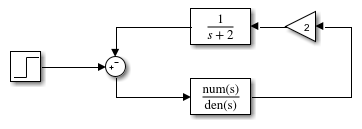I'm starting to learn about the state-space representation and i'm facing some difficulties. Suppose we have a system with connected blocks, like the one below:
where
Sometimes we want to choose variables that have physical meaning as the state equations. Suppose that these physical variables are the output of the second order block, the derivative of this output and also the output of the first order block. But by writing the time-domain equation of the transfer function of the second order block, we see that a derivative of the input will appear. Since we cant have an input derivative in a state equation, it makes me believe that I cant choose those variables, since:
If we took this block as an entire system, we couldn't do much more. But in an interconnected system, like the one above, is there a way i can relate the state equations of the other blocks so i can represent the second order block with those variables? For instance, we see that the derivative of the second order block input is equal to the derivative of the output of the first order one, since they differ by a constant, and also the output of the second order one is related with the input of the first order block. So is there a way i can represent the second block with those variables considering the interconnection?
Thank you.



